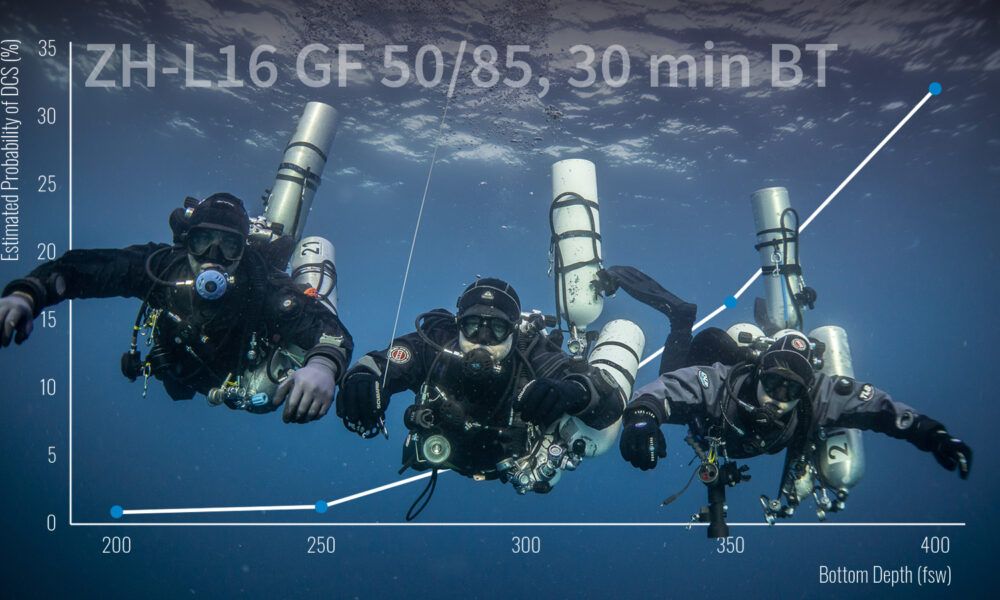bardass
Registered
Computers like the ScubaPro G2 were running like GF 90/90 at the "L0 conservatism" level.
how do you know that ?
Welcome to ScubaBoard, the world's largest scuba diving community. Registration is not required to read the forums, but we encourage you to join. Joining has its benefits and enables you to participate in the discussions.
Benefits of registering include
Computers like the ScubaPro G2 were running like GF 90/90 at the "L0 conservatism" level.
Good question, fortunately there is an older thread on here where this came up, and someone actually compared profiles to arrive at this:how do you know that ?
Negative ghostrider...It doesn't matter because Erik Baker's GFs never cross the M-value line. If you consider 100/100 "safe enough" then 100/90 should be "safer than enough"; it is unlikely that you'd have more people bent on 100/90 that on 100/100.
The testing will only tell you something new if you push a(*) GF past 100.
*) either of them
Negative ghostrider...
First I'm pretty sure that 100/100 hasn't been considered statistically "safe enough" for quite some time.
You could do 90/70. It's like extra anti deep stop. I doubt there is any human testing of this kind of approach so best of luck with it
This is only true for X=100. If we depart from that and compare 10/100 to 100/100, I believe the probability of DCS is higher in the 10/100 case. They both have all tissues below their respective M values. However, the slower tissues are closer to their limits -- and remain that way for longer -- in the 10/100 case.Theoretically no GF setting X/Y can get more people bent than 100/100, only fewer.
This is only true for X=100. If we depart from that and compare 10/100 to 100/100, I believe the probability of DCS is higher in the 10/100 case. They both have all tissues below their respective M values. However, the slower tissues are closer to their limits -- and remain that way for longer -- in the 10/100 case.
I had to read this twice to make sure I was agreeing with it--here is more words about the ideaIf we depart from that and compare 10/100 to 100/100, I believe the probability of DCS is higher in the 10/100 case. They both have all tissues below their respective M values. However, the slower tissues are closer to their limits -- and remain that way for longer -- in the 10/100 case.
are you referring to thisNegative ghostrider...
First I'm pretty sure that 100/100 hasn't been considered statistically "safe enough" for quite some time. Second with enough monkeys developing probability curves of DCS isn't that hard. Which is exactly what the latest navy models are doing. And it wouldn't take a super deep dive for 100/100 to have a 100% probability of DCS, mostly likely somewhere in the 80-90m range. Would fewer than 100% of people be bent at 100/90? Probably, but go 10m deeper and you're right back to 100% DCS again because Buhlmann isn't isorisk, which makes calling it "safer" than 100/100 profile specific.

 indepthmag.com
indepthmag.com
I have, but I don't recall anything that contradicts what I said. It is quite focused on the leading compartment, and I am primarily talking about the rest of them. Would you mind being more specific about which statement(s) you disagree with? Are you saying that 10/100 does not yield higher tensions in the slower tissues than 100/100? That there is not more total inert gas in the body (all tissues combined) after surfacing on 10/100? Or that the total loading does not remain higher for longer on 10/100? Or that those aspects do not increase the probability of DCS?Nope. Read Erik's paper.
Good question, fortunately there is an older thread on here where this came up, and someone actually compared profiles to arrive at this:
Difference between MB levels and Gradient Factors
Hi all! I was wondering if anyone could explain the difference between MB Levels (found on Scubapro computers) and gradient factors? I have a Scubapro G2 running Buhlman ZHL-16 ADT MB and I'm unsure what the distinction is between the different programmable MB levels (for added conservatism) vs...scubaboard.com
I had been told it was just plain old 100/100, but evidently someone went on a 'deeper dive' to find out!
